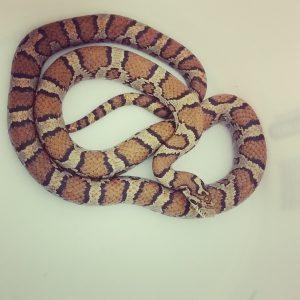What To Do If You Found a Sick or Injured Snake
Identifying Snakes

There are 14 species of snakes in Massachusetts. Only 2 species are venomous, the timber rattlesnake and the copperhead. These 2 species are endangered and are present in low numbers and in isolated areas of the state. Therefore, if you see a snake in your yard or your basement, it is highly unlikely to be venomous. Although many people have a fear of snakes, the snake is actually more afraid of you than you are of it. See the links below for help identifying snakes and for tips on what to do if you see an uninjured snake in your yard or house.
Typical injuries to snakes
At Tufts Wildlife Clinic, we most commonly see snakes that have suffered a bite wound from a dog or a cat or have been injured in the road. Obvious signs of injury include wounds along the body or if a snake seems unable to move part of its body. For example, the front half of the snake moves, but the back half appears limp. Small snakes can also become stuck to glue traps.
Materials to gather
- Find a container big enough to hold the snake and poke holes in the lid (before putting the snake inside)
- Alternatively, use a pillowcase to secure the snake.
Capturing the snake
If you see a snake in need of help, here are some pointers about handling and transporting:
- Try to gently scoop the snake into a container with a tight-fitting lid. Be sure to poke air holes in the container.
- Another option is to scoop the snake into a pillow case and knot the open end.
- Although most snakes rarely bite, it may try to do so if the snake is scared and injured. Rather than picking the snake up with your hand, try gently sliding the snake into the container or pillowcase using a stick or other object.
- If the snake is stuck to a glue trap, do not try to remove it yourself in order to avoid damaging its skin.
- It is not necessary to try to feed the snake or offer water, and it is best not to try to treat any injury you might observe.
Transport
If you cannot transport the snake to Tufts Wildlife Clinic immediately or if the Clinic is not open, keep the snake in a warm, quiet place in the tightly sealed container until you are able to bring it to the Clinic.
For further assistance on Transport, please refer to the "Who to Call for Help" section on this page.
During transport, keep the snake in the box or crate, keep the car quiet (radio off).